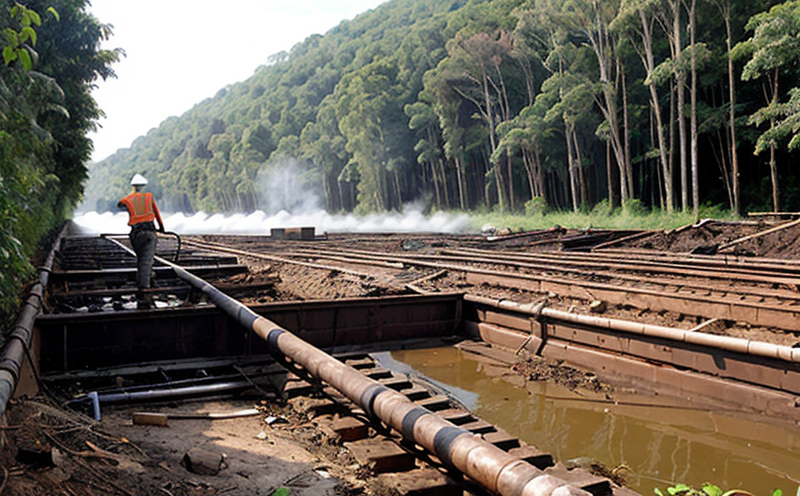ASTM E3026 Risk Based Environmental Assessment Test
The ASTM E3026 standard provides a systematic approach to conducting risk-based environmental assessments. This method is designed to prioritize areas of concern within industrial sites, commercial properties, and residential neighborhoods where potential contamination might exist. By leveraging advanced statistical techniques and geospatial analysis, the test helps organizations focus their efforts on those locations that pose the highest risk to human health or the environment.
The ASTM E3026 process involves several key steps: site characterization, data integration, statistical modeling, and decision support. Site characterization includes collecting soil and groundwater samples at various points across the property being assessed. These samples are analyzed for contaminants such as heavy metals, volatile organic compounds (VOCs), polychlorinated biphenyls (PCBs), among others.
Data from these analyses is then integrated with other relevant information about the site's history and current operations. This could include records of previous spills or leaks, nearby landfills or industrial activities known to release pollutants into the environment. Statistical models are used to predict areas where contamination levels exceed regulatory thresholds or pose significant risks even if they fall below those limits.
Once these high-risk zones have been identified through this rigorous process, organizations can allocate resources more effectively towards remediating these specific areas rather than conducting blanket investigations that may not yield meaningful results. This targeted approach not only saves time and money but also ensures compliance with environmental regulations while minimizing disruption to normal operations.
Compliance officers responsible for ensuring adherence to local, state, or federal laws regarding hazardous waste management will find ASTM E3026 particularly useful. It provides a framework that aligns with many regulatory requirements without being overly prescriptive, allowing flexibility based on individual circumstances. For quality managers looking at long-term sustainability goals within their organizations, this test offers valuable insights into current environmental conditions which can inform strategic decisions regarding future investments in green technologies or changes to existing processes.
Research and development (R&D) engineers involved in designing new products that interact with the environment can benefit from understanding potential risks early on during product lifecycle planning. They may use data generated by ASTM E3026 assessments to identify necessary modifications needed to prevent accidental contamination of ecosystems during manufacturing or end-of-life disposal stages.
In summary, ASTM E3026 Risk-Based Environmental Assessment is a powerful tool for identifying and addressing environmental risks efficiently. Its structured approach ensures that critical areas are addressed first, leading to more effective remediation efforts and better overall compliance outcomes.
Industry Applications
The ASTM E3026 standard finds extensive application across various industries where land use changes or industrial activities could potentially impact the environment. Some key sectors include:
- Manufacturing: Factories producing chemicals, electronics, and other materials often have large areas of land used for storage and processing. Regular assessments help maintain compliance with strict emissions controls.
- Real Estate Development: Developers must ensure that new residential or commercial projects do not pose risks to residents' health due to historical pollution issues on site.
- Transportation Infrastructure: Construction of roads, railways, airports typically involves extensive earthworks which could disturb existing contamination layers.
In each case, the goal is to reduce liability exposure by minimizing the risk associated with unknown or poorly understood environmental conditions. By using ASTM E3026, companies demonstrate a commitment to sustainable practices that protect both people and natural resources.
International Acceptance and Recognition
- Australia: The Australian Environmental Protection Authority (EPA) recognizes the value of risk-based approaches like those outlined in ASTM E3026. Many states have adapted similar methodologies to prioritize their own assessment programs.
- Canada: Provincial and territorial environmental ministries often cite this standard when developing guidance documents for local governments conducting site assessments.
- Europe: Countries across the EU frequently reference ASTM E3026 in national implementation plans for implementing directives such as the Water Framework Directive or Soil Protection Directives.
- Japan: Although not officially recognized, many Japanese companies voluntarily adopt international best practices like those specified by ASTM to ensure they meet global standards of excellence.
The widespread adoption of ASTM E3026 demonstrates its relevance and effectiveness beyond North America. Its flexibility allows it to be adapted according to local needs while maintaining consistency with broader international frameworks for environmental protection.
Use Cases and Application Examples
Let us explore some specific scenarios where the ASTM E3026 Risk-Based Environmental Assessment Test has been successfully implemented:
- New Industrial Facility Site Selection: A manufacturer considering expanding its operations sought to identify suitable locations for a new plant. Using ASTM E3026, they were able to pinpoint areas with minimal existing contamination, thus reducing initial remediation costs significantly.
- Brownfield Redevelopment Project: During the cleanup phase of a former industrial site intended for residential conversion, detailed assessments guided the team towards focusing on certain contaminated spots instead of treating entire parcels equally. This approach accelerated completion timelines and reduced overall project expenses.
- Retrofitting Older Facilities: An oil refinery wanted to upgrade its waste management practices without causing significant downtime. By applying ASTM E3026, they could focus their efforts on modernizing only those parts of the facility where outdated systems presented higher risks.
These examples illustrate how integrating risk-based methodologies into everyday decision-making processes can lead to more efficient and effective outcomes across diverse contexts.





